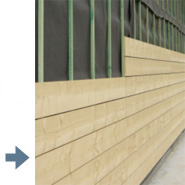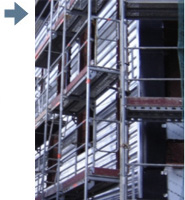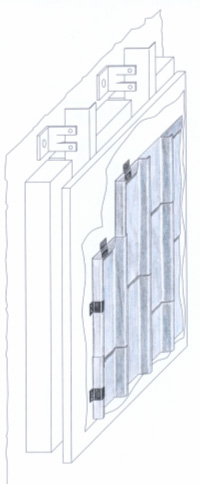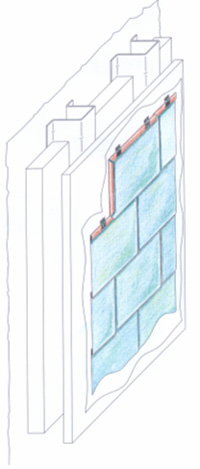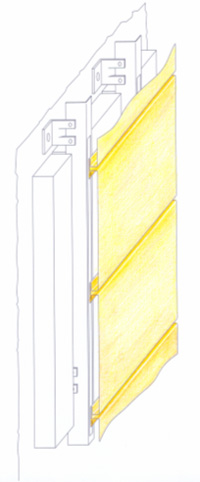 Facades
Pre-patinated copper facade, Plaza del Rey, Burgos (caption) IntroductionHere we will briefly look at the possibilities for constructing the facade and the potential systems. All Quinta Metálica® facades are built by installing several layers of different materials on top of each other, where each layer has its own particular function. If we start from the outside, moving inwards, we have the following generic layers.
Layers in detailSeparator plate / ventilation membrane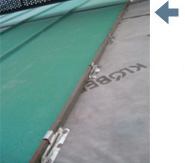
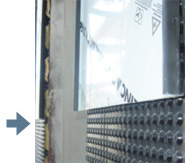
This membrane makes it easier for the panelling to dilate (in response to thermal changes) because it provides a surface over which the metal can easily slide. Quinta Metálica uses breathable membranes because they provide both functions effectively and they also help to protect the facade against condensation, trapping the water between it and the inside of the metal, until it drains down towards the start of the facade or evaporates. For zinc and lead facades, Quinta Metálica always installs a ventilation membrane because it lets the inside of the metal breathe, preventing the condensed water from making contact with the zinc, prolonging the metal's useful life. Direct support for seam and butt joint facadesThe systems to cover a facade that we use most often – the seam and the butt joint - are made with thin metal plates and therefore require direct support (the support immediately below the metal) that stretches over the whole or almost whole metal surface. This support withstands all the forces transferred from the panelling to the main structure. The support has to be reasonably smooth and regular, as any appreciable defect will be transmitted through the covering and will be visible, giving the facade poorer quality.
Direct support for panel facades
If the facade is going to be produced in the facade panel system or in cassette panels, the support is not continuous as we make the most of the fact that the panels in both systems are self-supporting. In these cases, the support is composed of metal battens, with spacing of around 600mm. For cassette panel covering, they will always be fitted vertically, but for tongue and groove joint facade panels, we fit them in the opposite direction to fitting panels, that can be fixed horizontally or vertically. Not all support materials are suitable for each metal – see the pages for each metal to obtain a list of correct materials. Thermal insulationNeither the type of insulation chosen for the roof nor its thickness has any influence on the panelling. Only in the event that the insulation provides direct support for the metal must it meet a specific requirement - it must withstand temperatures of 80ºC without being damaged. UpThermal design – ventilated and non ventilated facadeThe top layers described above can be interspersed to give two types of facade – the ventilated facade and the non ventilated facade. Quinta Metálica makes both versions. The metal facade and condensationThe basic problem for a metal facade is that we have a vapour barrier exactly where we don't want it – on the cold side of the facade. If we do not design the facade carefully, it can produce significant quantities of condensation that will damage the building and its contents. This is particularly important when the humidity inside the building is high – swimming pools, gymnasiums, kitchens, etc. or the building is located in an area with very cold winters. To prevent this happening, Quinta Metálica provides two different solutions: the ventilated facade and the non ventilated facade. The ventilated facadeThis solution protects the facade from condensation by carrying the damp air (from inside the building) outside by means of a moving air sheet. This air sheet runs in front of the insulation (between the insulation and the direct support that supports the covering) and goes continuously from its air inlet at the start of the facade to its outlet on the top. In Spain there are no rules to restrict the size of this chamber but based on our own experience and the rules in other countries, we recommend a chamber height of between 20 and 30mm. Contact Quinta Metálica for more information. This plate is built with vertical metal battens (or vertical wooden bars) that have a height equivalent to the thickness of the thermal insulation required, plus an additional 20 to 30mm to create the chamber. The details that Quinta Metálica uses make sure that the air inlet at the start and the outlet on the coronation are large enough to generate appropriate ventilation. The non ventilated facadeThis solution protects the facade from condensation by fitting a vapour barrier below the thermal insulation. This barrier has the function of eliminating the possibility of filtrations of damp air from inside the building through the insulation towards the cold parts of the roof and condensing. Its correct operation is fundamental so in our opinion it is important that it has a continuous support that makes it easier to fit and seal its joints perfectly. In this roof solution, there is no air chamber. Which solution should we apply?The ventilated facade works well in Spain with all metals. This is compulsory when we are panelling with zinc or lead. It is suitable for all facades, eliminates thermal bridges in the intersection with the ironwork and dissipates heat in the summer. Panel systems are almost always ventilated. However, when the additional cost to ventilate the facade is significant, when the total thickness of the facade is very limited, or when the facade has many windows and its ventilation will not be particularly practical, the non ventilated facade with its vapour barrier will be the best option. To get technical evaluation for your project facade's thermal design, please contact Quinta Metalica and we will help you to design your facade properly. Examples of building facades:
Metal panellingThe crimped systems that we use on the facade are seam and butt joint and the panel systems are tongue and groove joints facade panels and cassette panels. The seam and butt joint systems, due to being cheap and flexible, are far and away the most used by Quinta Metálica. Choosing the systemThe panelling system is usually chosen according to two criteria - economics and aesthetics. Looking at the question of costs first, and taking into account that each site is different and its characteristics and the metal used influence the calculation, panel systems can cost between 20 and 50% more than the crimped systems. To get an accurate estimation, we recommend that you contact us and after technical evaluation, we will provide you with a quote without commitment for the most appropriate systems. As far as aesthetic considerations are concerned, the best way of comparing is to consult photographs of works carried out using each system and decide which fits best in each project. In any case, the following comments are summarised in the table below.
For more information on each system, please refer to the files for each of them. 
Workshop Building in Calle Trole, Vallecas, Madrid. Facade with vertical seam (caption) InstallationIn all the aforementioned systems except for the tongue and groove joint panels, installation starts in the lower part of the facade, fitting the start piece and fastening strips. Here we pay particular attention to these elements as they form the lower contour of the facade. The fastening strips or side pieces required to install the lateral end pieces on the facade are fastened next. The facade elements can then be fitted. We make sure that they are correctly aligned and positioned in accordance with the facade exploded drawing. In finishes that have different shades from sheet to sheet, we try to make a random distribution. We then finish the facade by installing the end pieces around the windows, curtain wall, doors, ventilation grills, etc. Throughout this whole process we try to make sure that:
We take it for granted that the facade with be waterproof and will protect the building for decades from everything the weather has to throw at it. 
Regional Animal Health Laboratory, Villaquilambre. Pre-patinated zinc facade (caption) Request for information
For technical consultancy on your project, please contact Quinta Metalica and we will be happy to help you.
Up Representative works Centro de Interpretación Puerto del Atlántico
Huelva Centro de Interpretación Puerto del Atlántico
Huelva
 Supermercado Aldi. Calpe
Calpe. Alicante Supermercado Aldi. Calpe
Calpe. Alicante
 Supermercado Aldi. Sueca
Sueca. Valencia Supermercado Aldi. Sueca
Sueca. Valencia
 Vivienda unifamiliar. Toledo
C/ Coronel Baeza. Toledo Vivienda unifamiliar. Toledo
C/ Coronel Baeza. Toledo
 Bodega Casona Micaela
Villa Verde de Trucios. Cantabria Bodega Casona Micaela
Villa Verde de Trucios. Cantabria
 Centre de Congressos i Exposicions
Andorra La Vella Centre de Congressos i Exposicions
Andorra La Vella
 Centro de Día
Cardedeu. Barcelona Centro de Día
Cardedeu. Barcelona
 Edificio Tecma
Alzira. Valencia Edificio Tecma
Alzira. Valencia
 Rehabilitación fachada C.P.M. Internacional
San Martin de la Vega. Madrid Rehabilitación fachada C.P.M. Internacional
San Martin de la Vega. Madrid
 Centro Comercial Plaza Imperial
Zaragoza Centro Comercial Plaza Imperial
Zaragoza
 Vivienda unifamiliar. Somosaguas
Somosaguas. Madrid Vivienda unifamiliar. Somosaguas
Somosaguas. Madrid
 Laboratorio Regional de Sanidad Animal
Villaquilambre. León Laboratorio Regional de Sanidad Animal
Villaquilambre. León
 24 Talleres en Calle Trole
Madrid 24 Talleres en Calle Trole
Madrid
 Hospital de San Pedro
Logroño Hospital de San Pedro
Logroño
 Vivienda unifamiliar
Carbajal de La Legua. León Vivienda unifamiliar
Carbajal de La Legua. León
 Centro de Atención al Ciudadano
Haro. La Rioja Centro de Atención al Ciudadano
Haro. La Rioja
 Vivienda en Villafranca del Castillo
Villafranca del Castillo. Madrid Vivienda en Villafranca del Castillo
Villafranca del Castillo. Madrid
 110 viviendas en Plaza del Rey
Burgos 110 viviendas en Plaza del Rey
Burgos
 Vivienda unifamiliar en Guarda
Guarda. Portugal Vivienda unifamiliar en Guarda
Guarda. Portugal
 Viviendas en Montecarmelo
Montecarmelo. Madrid Viviendas en Montecarmelo
Montecarmelo. Madrid
 Vivienda Casa Galán
Pamplona Vivienda Casa Galán
Pamplona
 15 viviendas y garajes
Benalmádena Costa 15 viviendas y garajes
Benalmádena Costa
 Club Nautico Alcazar
Cádiz Club Nautico Alcazar
Cádiz
 Edificio de viviendas en Calle Córdoba
Puerta del Mar, Málaga Edificio de viviendas en Calle Córdoba
Puerta del Mar, Málaga
 Fundación San Telmo
Málaga Fundación San Telmo
Málaga
 Polideportivo de Vic
Vic Polideportivo de Vic
Vic
 Residencia las Navas del Marques
Las Navas del Marques - Avila Residencia las Navas del Marques
Las Navas del Marques - Avila
 La Laguna de Fuente la Piedra
Fuente la Piedra - Malaga La Laguna de Fuente la Piedra
Fuente la Piedra - Malaga
 - copia.jpg) Enciso El Barranco Perdido
Enciso, La Rioja
Pla de Palau
Pla de Palau, Barcelona Enciso El Barranco Perdido
Enciso, La Rioja
Pla de Palau
Pla de Palau, Barcelona
|
© Quinta Metálica · c. Juan Bautista Escudero 273· Córdoba· 14014 Córdoba
Tel.: 91 896 1898· arquitectura@quintametalica.com
Legal Advice


